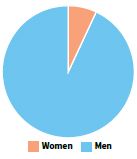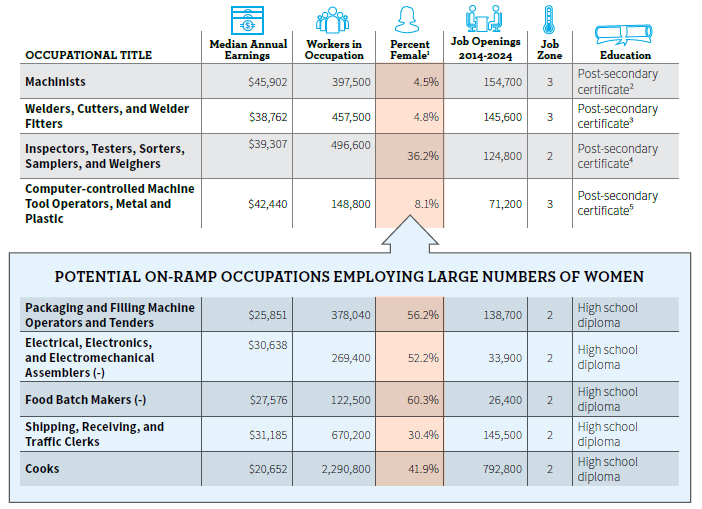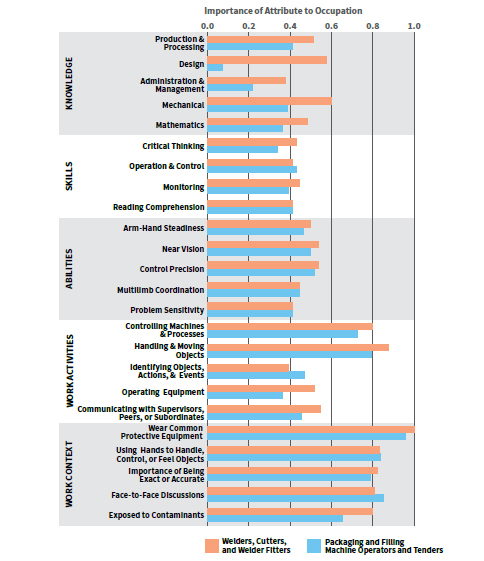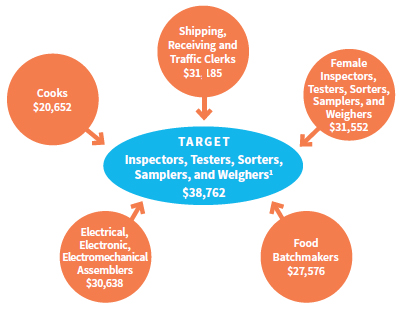Advanced Manufacturing
The manufacturing industry employs twelve million workers in the United States (U.S. Bureau of Labor Statistics Current Employment Statistics 2015). Compared to the U.S. economy overall, manufacturing employs a higher share of non- college educated workers, with higher median hourly earnings, than other non-college educated workers (Scott 2015) and a greater likelihood that employers provide benefits such as retirement contributions or healthcare insurance (Joint Economic Committee 2013). After several years of decline, employment in manufacturing has started to grow again (Scott 2015). Added to growth in the number of jobs are projected recruitment needs due to the prospective retirement of a substantial number of the current workforce; over half of all workers in the industry are 45 years and older (Joint Economic Committee 2013). Industry estimates suggests that over the coming decade the industry will need to fill 3.4 million jobs (80 percent of these due to pending retirement of baby boomers). Industry estimates further suggest that only 1.4 million of the projected 3.4 million manufacturing jobs can be filled by the current workforce, requiring substantial investments in training and education to ensure that manufacturing growth is not held back by skill shortages (Deloitte and Manufacturing Institute 2015). Job growth and employment in manufacturing is not evenly spread across the country, but a number of localities, including Michigan, New York, Illinois, Oregon, Tennessee, and Wyoming have seen a resurgence of employment in the sector (Kotkin and Shires 2015). Hard-to-fill vacancies in middle-skill manufacturing jobs are a theme echoing across the country (JP Morgan Chase New Skills at Work, various). Some argue that the difficulty in finding suitably trained workers to fill these vacancies is threatening to hold back the growth of the manufacturing sector and the return of manufacturing jobs to the United States (Accenture & Manufacturing Institute 2014).
Figure 2.1 Women are a small minority of workers in good growing manufacturing jobs
Women’s Share of Employment in Advanced Manufacturing Occupations with a Minimum of 25,000 job
Openings and at least $35,000 Median Annual Earnings

Note: For definition of good middle-skill jobs see Appendix A.
Source: IWPR calculation based on IWPR O*Net database (see Appendix A).
So far women have not benefitted from the renewed growth in manufacturing: while men’s employment in manufacturing increased from 2010 to 2014, women’s has remained flat. Between 2010 and 2014 men’s employment in manufacturing grew by 614,000 jobs (to 8.8 million); women’s employment in manufacturing during the same period only increased by 44,000 jobs – just 7 percent of all new jobs in manufacturing even though women are 27 percent of the manufacturing workforce.[1]
Table 2.1 shows the four middle-skill manufacturing occupations projected to have the highest number of job openings nationally between 2014 and 2024. Each of these occupations has median annual earnings that would lift an adult with two children out of near-poverty, and none of them require an associate’s or bachelor’s degree. Women are a minority of workers in each of these occupations, and in three of the occupations women are fewer than one in ten of current workers. The pending generational change in manufacturing, and the resulting need for training of a new generation of middle-skill workers in manufacturing, provides an opportunity to improve the diversity of the workforce and increase the number of women working in these occupations.
Table 2.1 Middle-skill Manufacturing Occupations with High Levels of Projected Jobs Openings and Potential Female On-ramp Occupations

Notes: (-) Occupation is projected to decline. Projected job openings from employment growth and employee turnover; full-time year-round earnings and full-time year-round workers in occupation. 139 percent of respondents to O*Net incumbent survey for occupation had a high school diploma or equivalent; 19 percent had a post-secondary certificate; and 15 percent had some college or no degree. 252 percent of respondents to O*Net survey for occupation had a high school diploma or equivalent; 14 percent had less than a high school diploma; and 14 percent had a post-secondary certificate. 341 percent of respondents to O*Net survey for occupation had a post-secondary certificate; 40 percent had a high school diploma or equivalent; and 13 percent had some college or no degree. 450 percent of respondents to O*Net survey for occupation had a post-secondary certificate; 34 percent had a high school diploma or equivalent; and 5 percent had an Associate degree.
Source: U.S. Department of Labor “O*Net online http://www.onetonline.org/ and IWPR O*Net Database.
Table 2.1 also lists five potential on-ramp occupations for women to these occupations: the occupations have lower median annual earnings; they are majority female or employ at least 100,000 women; and—apart from being female and lower paid—have comparatively similar occupational attributes, as measured through O*Net, to those required in the growing higher paid middle-skill occupations employers are seeking to fill.
The largest non-clerical manufacturing occupation is ‘Packaging and Filling Machine Operators and Tenders,’ an occupation which employs over 200,000 women (who are 56 percent of workers in the occupation). Typically working in this occupation requires a high school diploma, as well as some on-the-job training. Median annual earnings for full-time work are only $25,851 (and just $23,183 for women). Women working as ‘packaging and filling machine operators and tenders’ are already familiar with the manufacturing environment; the skills profiles of the occupation is similar to the fast growing higher paid predominantly male occupations in Table 2.1. Figure 2.2 lists the most relevant attributes for the occupation of welders, and matches the O*Net values for each attribute for welders and packaging and filling machine operators. Just as welders or machinists, they require arm-hand steadiness, manual dexterity, and control precision; work activities require controlling machines and processes, wearing protective clothing, and being on one’s feet most of the time (Figure 2.2).
Figure 2.2 Skills Profiles: Welder (Median Earnings of $38,762) and Packaging and Filling Machine Operators and Tenders (Median Earnings of $25,851)

Notes: *O*Net data collection uses different scales for different attributes; to allow comparability, all scales have been normalized to 0.0 to 1.0 scale. The closeness value between the two occupations based on all attributes in the O*Net database is 0.091. Median earnings are for full-time, year-round workers in 2014 dollars, adjusted using CPI-U-RS. Attributes listed are those highlighted as most important for welders on O*Net database.
Source: IWPR compilation based on U.S. Department of Labor “O*Net online http://www.onetonline.org/ and IWPR O*Net database.
‘Electrical, electronics, and electromechanical assemblers’ provide a similar example of an occupation that shares many attributes with the high growth advance manufacturing occupations in which employers report skill shortages. The occupation employs more than 100,000 women and is declining. To advance from working as a packaging and filling machine operator or an electrical, electronics, and electromechanical assembler to working as a welder or machinist requires additional training on and off the job. Yet the women working in these jobs already have many of the required experiences and attributes, most importantly a familiarity with working in manufacturing. Women working in these lower skilled manufacturing occupations provide a good recruitment pool for identifying workers interested in advancing their careers through further training and education.
‘Inspectors, testers, sorters, samplers, and weighers’ is the manufacturing occupation with the third highest level of projected job openings; unlike the other high growth target occupations in Table 2.1, a substantial number of women already work in this occupation (36.2 percent of full-time, year-round workers, and 40.4 percent of all workers, Table 2.1 above). Yet women fare rather differently in the occupation than men. While the occupation provides access to family-sustaining wages for men- median annual earnings for men in the occupation were $44,265—median annual earnings for women were much lower at just $31,552, and a gender earnings ratio of only 71.3 percent. This suggests that women working in this occupation are either segmented into a lower paid subsection of the occupation, or are employed in firms that provide lower earnings. For employers seeking to fill vacancies starting with an active search for women workers already in the occupation may be the most cost effective route to address their need for skilled staff.
Figure 2.3 Inspectors, Testers, Sorters, Samplers, and Weighers and Possible On-Ramp Occupations With a High Number of Low Wage Women

Notes: 152 percent of respondents to O*Net incumbent survey for occupation had a high school diploma or equivalent; 14 percent had less than a high school diploma; and 14 percent had a post-secondary certificate. Median earnings are for full-time, year-round workers in 2014 dollars, adjusted using CPI-U-RS; see Appendix. The distance value from ‘inspectors’ to food batch makers is 0.065; to shipping & receiving clerks 0.079; to packaging and filling machine operators 0.087; and to cooks 0.089. See methodology section.
Source: U.S. Department of Labor “O*Net online and IWPR analysis of IWPR O*Net database (see Appendix A).
‘Food batch makers’ is an example of an on-ramp occupation, that is, it is lower skilled (requiring a high school diploma) and lower paid than ‘inspectors, testers, sorters, samplers, and weighers’, but has many similar occupational attributes. Food batch makers work in food processing plants and may record production and test data for each food product batch, follow recipes to produce food, and set up, operate, clean and sterilize food processing equipment.[2] Slightly more than half of 105,000 workers in the occupation are women, with median full-time year-round earnings of $27,565. Career advancement to ‘inspectors, testers, sorters, samplers, and weighers’ does not only offer higher earnings but also more secure employment prospects given the prospective long-term decline of employment of ‘food batch makers.’ Almost as closely matched to inspectors are ‘shipping, receiving, and traffic clerks,’ another lower skilled occupation that employs 170,000 women (the occupation is 30.4 percent female), with median earnings for all workers of $31,185.
Focusing on the similarities between these occupations may persuade some cooks that manufacturing could present a viable, more lucrative career choice when they are considering their next steps toward gaining skills and developing credentials.
A somewhat less traditional example of a possible on-ramp occupation are ‘cooks.’ ‘Cooks’ are a large occupational group, with more than 2 million workers, including 780,000 women. Median annual earnings for full-time work were only $20,652. Just as in manufacturing, work as a cook typically requires being on one’s feet for most of the day, manual dexterity and arm-hand steadiness, work with potentially dangerous equipment, and knowledge of production processes, quality control and other techniques for maximizing the effective manufacture and distribution of goods (O*Net Online 2015). Manufacturers often lament the lackluster reputation of the manufacturing industry as a barrier to recruitment: too noisy, dirty, and not seen as cutting edge by parents or prospective trainees. Women and men working as cooks in institutional and restaurant kitchens share many of the same work environment and worker attributes. Focusing on the similarities between these occupations may persuade some cooks that manufacturing could present a viable, more lucrative career choice when they are considering their next steps toward gaining skills and developing credentials.
Attracting women to manufacturing
Many employers in manufacturing are recognizing that increased diversity is a necessary part of addressing their needs for talent. Initiatives include enhanced outreach and recruitment efforts, explicit messaging and changes in organizational culture, networking and mentoring for women already in the industry, and flexible working practices that make it possible for (male as much as female) employees to be both effective at work and care for their families (Deloitte 2015). Initiatives to attract women to manufacturing tend to be focused on more highly skilled executive and professional positions. Yet there are fewer initiatives that specifically target women for pathways to middle-skill manufacturing occupations. The American Welding Society has reached out to women as part of its drive to diversity the occupation and address recruitment issues (American Welding Society 2013). The Industrial Division of the Communications Workers of America (IUE-CWA), for example, along with others, has instituted women’s councils to uproot the stereotype of manufacturing as male-dominated (Pastor and Sanchez, 2015).
Many employers in manufacturing are recognizing that increased diversity is a necessary part of addressing their needs for talent
Pathways to skilled occupations in advanced manufacturing are provided through the U.S. Department of Labor‘s (DOL) American Apprenticeship $175 million grant program (U.S. Department of Labor, 2015a). An explicit goal of the apprenticeship initiative is to market the value of apprenticeship as a pathway to a certified skilled workforce, and to make apprenticeship more attractive to women. A number of the projects funded under the grant program are explicit about their efforts to increase women’s access to apprenticeships in advance manufacturing (U.S. Department of Labor 2015b):
- The Wisconsin Apprenticeship Growth and Enhancement Strategies (WAGE$) project is receiving grant funding to train 1,000 new apprentices and 542 upskilled incumbent workers in 12 high-growth occupations in the Advanced Manufacturing and other high growth sectors. Partners in the WAGE$ project include Chicago Women in Trades (CWIT) who will provide technical assistance and pre-apprenticeship programs to ensure women have a fair shot as these opportunities.
- The Southeast Michigan Community Alliance is receiving grant funding to develop its Advance Michigan Center for Apprenticeship Innovation (CAI) project, specifically targeted at building and developing apprenticeship programs in the high-demand, new-age automotive and transportation sectors of the Advanced Manufacturing industry. The grantees plan to work with organizations such as the Michigan Council of Women in Technology, Detroit Area Pre-College Engineering Program and Black Girls Code. CAI will serve more than 800 workers in the State of MI.
- Marshall University Research Corporation’s Robert. C. Byrd Institute for Advanced Flexible Manufacturing is receiving grant funding to build a National Advanced Manufacturing Apprenticeship Program, with the explicit goal of expanding existing innovative apprenticeships and promote advanced manufacturing pre-apprenticeships for women, transitioning military personnel, and disadvantage youth. The program will serve 1,000 apprentices and 415 pre-apprentices nationwide.
A small number of community training programs offer pre-apprenticeship programs for women in manufacturing. Pre-apprenticeship programs provide a basic introduction to what it is like to work in advanced manufacturing; they can help women decide whether, and which parts of the industry, may be right for them and they prepare the pre-apprentice to meet the entry requirements of apprenticeship programs (U.S. Department of Labor ETA 2015). Chicago Women in the Trades (CWIT) and Oregon Tradeswomen Inc. (OTI) are offering women-only programs directly relevant to advanced manufacturing (see Appendix C for more details). An example of a women-only program in welding at community and technical colleges is provided by Wisconsin Indianhead Technical College.
